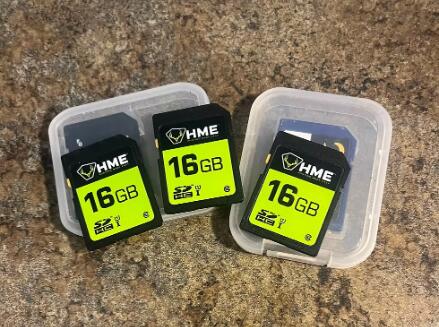When it comes to setting up a trail camera, selecting the right SD card is crucial for capturing clear images and videos, ensuring smooth operation, and avoiding data loss. The SD card acts as the storage medium for all of your camera’s captures, and understanding the specifications, compatibility, and performance will help you make an informed decision.
1. SD Card Types and Formats
Before diving into the specifics, it’s essential to understand the different types and formats of SD cards available in the market. SD cards come in three main formats: SD (Secure Digital), SDHC (Secure Digital High Capacity), and SDXC (Secure Digital Extended Capacity). Each type is distinguished by its storage capacity and speed:

SD Cards (Standard): These cards typically have a storage capacity of up to 2GB.
SDHC Cards (High Capacity): Ranging from 4GB to 32GB in size, SDHC cards are more commonly used in modern devices, including trail cameras.
SDXC Cards (Extended Capacity): These cards support storage capacities between 32GB and 2TB, making them ideal for high-resolution videos and images.
When selecting an SD card, always check the specifications of your trail camera to ensure compatibility with the card’s format. Many modern cameras require SDHC or SDXC cards for optimal performance.
2. Card Capacity: Choosing the Right Size
The capacity of the SD card is directly related to how much data it can store, and this is critical when considering how long you want to leave the trail camera in place before swapping or retrieving the card. Higher capacity cards allow you to store more photos or videos, which is particularly useful if you’re in a remote area without easy access to retrieve or swap cards frequently.
For Standard Use: If you’re using your trail camera to capture basic images or if it’s set up to take only a few photos each day, an SDHC card with a 16GB or 32GB capacity should suffice.
For Video or Continuous Recording: If you’re recording videos or need a lot of storage for continuous shots, opt for an SDXC card with a capacity between 64GB and 128GB or more, especially if you’re capturing high-definition footage.
It’s worth noting that trail cameras set to take multiple images or videos daily can quickly fill up an SD card, so having a larger capacity ensures uninterrupted recording.
3. Speed Class: Ensuring Smooth Performance
The speed class of an SD card refers to how fast it can write and read data. For trail cameras, speed is important, particularly when shooting video or capturing a high volume of images. A slow card can cause delays in saving footage, leading to missed shots or camera malfunctions.
Class 10 Cards: These are the most commonly recommended cards for trail cameras. They offer a minimum write speed of 10MB/s, which is fast enough for most trail cameras.
UHS-I Cards: UHS-I cards are an upgraded version of Class 10 cards and are particularly useful if you’re recording in high-definition (HD) or 4K video. UHS-I cards offer higher read/write speeds and are perfect for ensuring smooth performance in more demanding setups.
UHS-II Cards: These are the highest performing cards, providing even faster speeds and better durability. However, not all trail cameras support UHS-II cards, so it’s important to check your camera’s compatibility before purchasing.
For optimal performance, always check your trail camera’s specifications and pair it with an SD card that matches its required speed class.
4. Durability: Ensuring Longevity in Harsh Environments
Trail cameras are designed for outdoor use, so the SD card you select must be able to withstand various environmental conditions. Extreme temperatures, humidity, and physical wear can affect the performance and longevity of your SD card. Therefore, it’s essential to choose an SD card built for outdoor conditions.
Temperature Resistance: Many SD cards are rated for operating temperatures ranging from -25°C to 85°C. This is crucial for trail cameras that are exposed to extreme weather conditions.
Waterproofing and Shock Resistance: Some SD cards offer water and shock resistance, providing additional protection if the card gets wet or experiences physical stress.
Long-Term Durability: Choose brands that are known for their reliability and long-term performance, such as SanDisk, Kingston, or Lexar. These brands often offer cards that are specifically designed for high-performance and durability in tough conditions.
5. Formatting the SD Card: Why and How
Formatting your SD card before use in a trail camera is essential for optimizing storage and ensuring the camera reads the card correctly. Many trail cameras require the SD card to be formatted in a specific file system, such as FAT32 or exFAT.
How to Format an SD Card for a Trail Camera:
Insert the SD Card into your computer.
Open your computer’s file manager (Windows Explorer or Finder for Mac).
Right-click on the SD card and select the “Format” option.
Choose the appropriate file system:
FAT32: Most common for cards up to 32GB.
exFAT: Required for cards above 32GB.
Ensure Quick Format is selected and click “Start” to begin formatting.
Once formatted, insert the card into your trail camera. This step ensures that the card is ready for recording and minimizes the risk of errors or corrupted files.
6. Choosing Reliable Brands and Models
When it comes to SD cards, reliability is key. While there are many budget options available, it’s often worth investing in a quality card from a trusted manufacturer. Here are some top SD card brands that are known for their durability, speed, and reliability:
SanDisk Extreme PRO: Known for its high-speed performance and reliability, the SanDisk Extreme PRO series is ideal for trail cameras used for video recording or high-resolution photos.
Kingston Canvas React: Kingston offers high-speed SD cards that are perfect for outdoor applications, including trail cameras.
Lexar Professional 1000x: Lexar’s high-performance SD cards are widely used in cameras, providing excellent write speeds and durability for demanding environments.
Transcend Ultimate: Transcend’s SD cards are designed for high-end cameras, ensuring fast write speeds and strong durability under harsh conditions.
Choosing a reputable brand will help ensure that your SD card performs well and lasts longer, even in challenging outdoor environments.
7. How to Maintain Your SD Card for Longevity
To get the most out of your SD card and ensure it performs optimally over time, consider these maintenance tips:
Avoid Overwriting Files: Continuous overwriting of files can degrade the lifespan of your SD card. If possible, periodically retrieve and store the data from your SD card.
Store SD Cards Properly: When not in use, store SD cards in a dry, cool place away from extreme temperatures. Avoid exposing the card to direct sunlight or humidity.
Use the “Eject” Function: Always eject the SD card from your computer or trail camera properly to prevent data corruption or damage to the card.
Regularly Back Up Your Data: Ensure that important footage or images are backed up to another device or cloud storage. This ensures that even if an SD card fails, you won’t lose valuable data.
8. Troubleshooting Common SD Card Issues
Despite their reliability, SD cards can sometimes face issues, especially in outdoor environments. Here are some common problems and their solutions:
Card Not Detected: This can occur if the card is not properly inserted or formatted. Try reinserting the card and reformatting it using the steps outlined above.
Data Corruption: Corruption can happen due to improper ejection or sudden power loss. If this happens, try using data recovery software to retrieve your files.
Card Full Error: If your card is full, try deleting unnecessary files or transfer the data to another storage device.
About us and this blog
Panda Assistant is built on the latest data recovery algorithms, ensuring that no file is too damaged, too lost, or too corrupted to be recovered.
Request a free quote
We believe that data recovery shouldn’t be a daunting task. That’s why we’ve designed Panda Assistant to be as easy to use as it is powerful. With a few clicks, you can initiate a scan, preview recoverable files, and restore your data all within a matter of minutes.
Subscribe to our newsletter!
More from our blog
See all postsRecent Posts
- How to recover deleted voicemail samsung? 2025-04-22
- Samsung portable ssd t5 online recovery 2025-04-22
- Fix western digital external hard drive 2025-04-22

 Try lt Free
Try lt Free Recovery success rate of up to
Recovery success rate of up to









